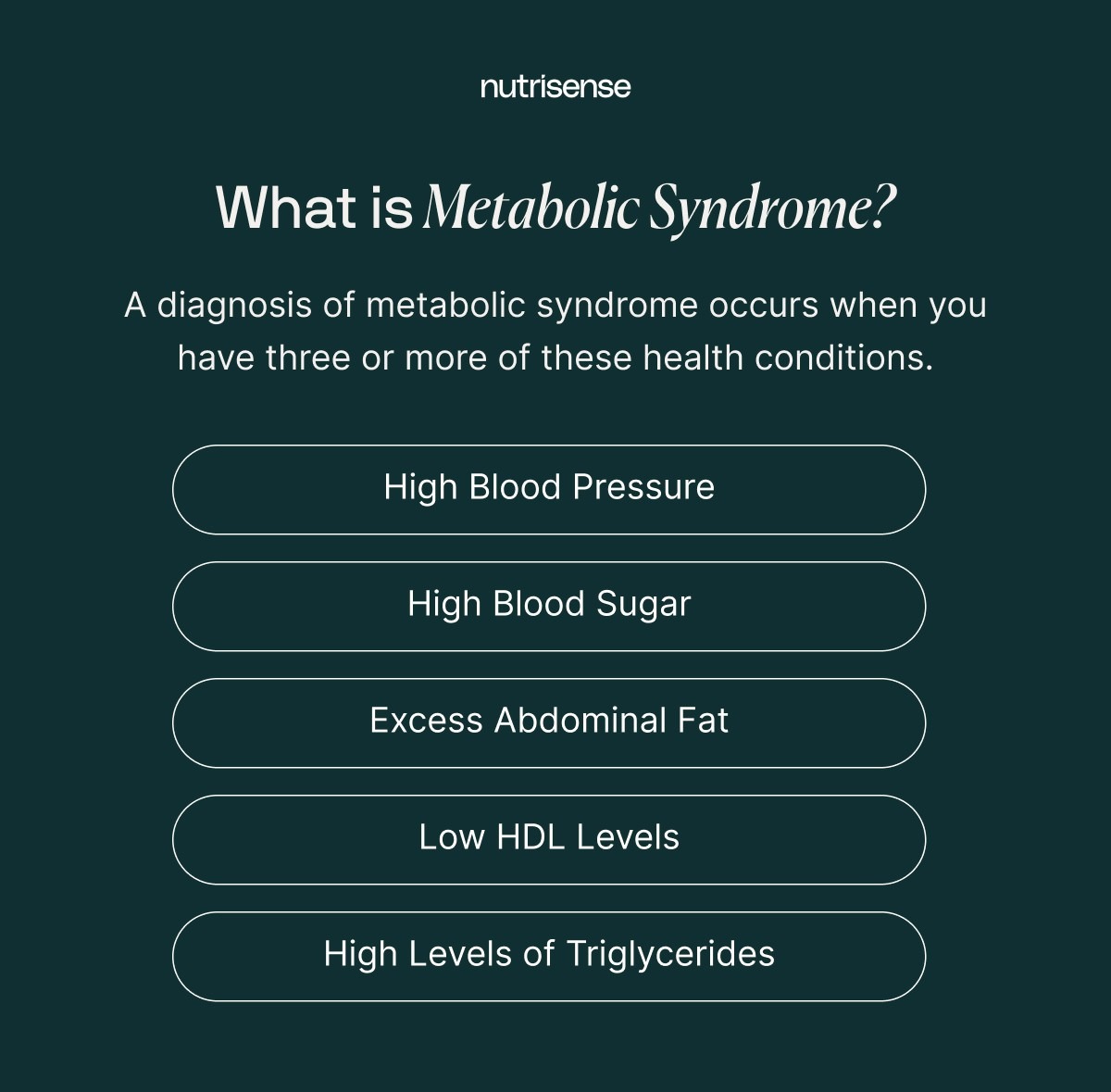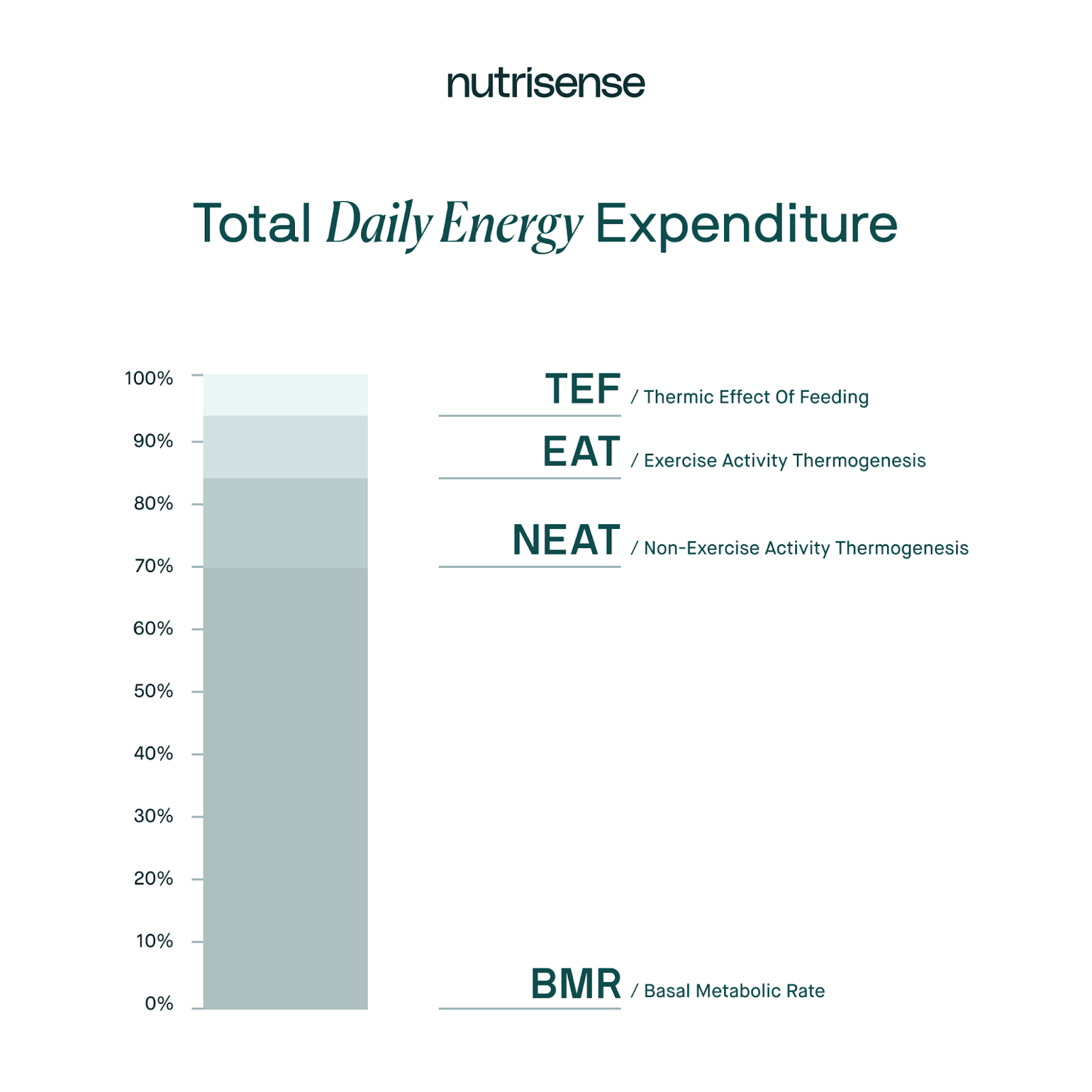Metabolic Health—Your Guide to What it is and Why it's Important

Key Takeways
Metabolic health reflects how well your body makes and uses energy from food. It is generally defined by having optimal levels for glucose, triglycerides, HDL cholesterol, blood pressure, and waist circumference, which supports your overall well-being. Improving your metabolic health can lead to more stable energy, easier weight management, and a lower risk of chronic diseases.
Key Takeaways:
- Good metabolic health is defined by five key markers: waist circumference, glucose levels, triglyceride levels, HDL cholesterol, and blood pressure.
- Factors like diet, exercise, sleep, and stress management are the foundational pillars for improving your metabolic function.
- Symptoms like constant fatigue, brain fog, or shakiness between meals can be subtle indicators of underlying glucose instability and poor metabolic health.
- The Nutrisense program combines 24/7 glucose data with 1:1 dietitian support to help you create a personalized plan to improve your metabolic health.
What should you remember about metabolic health?
Our body depends on all our organs working together to keep us alive. So, it would be quite an issue if any of those organs weren't functioning optimally! But we often forget about the thousands of complex chemical reactions that occur daily for our body to continue functioning well enough to keep us healthy.
The building blocks of metabolic health
These reactions are the building blocks of what we call metabolic health. Our metabolism is the reason for most of these chemical reactions, representing all those activities associated with breaking down food so we can have enough fuel to be active.
What is Metabolic Health?
Metabolic health can be challenging to define. Several factors about a person's overall health and circumstances may imply their metabolism is working optimally compared to someone with a different lifestyle and body than theirs.
When a 'Healthy' Day Leaves You Drained
You’re at your desk around 3 p.m., and a familiar wave of fatigue washes over you. You had a big salad for lunch and have been sipping water all day, so why is it so hard to focus?
This feeling of doing all the right things without getting the energy you expect is a classic sign that something is off with your metabolic health. It’s not about a lack of willpower, it’s about understanding your body’s unique response to food and activity.
So, it's easier to describe a metabolically healthy body as one without signs of metabolic syndrome. Read more about that later on in this piece!
Common markers
To gauge your metabolic health, your healthcare provider may examine various metrics, including your:
- Fasting glucose
- Triglycerides
- HDL-C
- Waist circumference
- Blood pressure
They'll also explore the risks, like family history and other genetic or lifestyle markers associated with poor metabolic health, so you can see how to improve it.
Why it matters
Metabolic health is, essentially, the absence of a healthy metabolism. It does not mean that you are a perfect size or that your body mass index (BMI) is "normal." In fact, you can be healthy at any size.
If you're in 'good metabolic health:'
- Your blood pressure is likely normal.
- Your glucose, cholesterol, and triglycerides are within acceptable limits.
- Your waist circumference is <40 inches (men) or <35 inches (women).
Good metabolic health can add years to your life. It also means a lower risk of chronic health issues, better weight management, improved mood, and decreased anxiety and depression, to name a few benefits.
How Your Body Uses Energy
Daily energy use comes from three parts BMR for resting needs, movement throughout the day, and the thermic effect of food. BMR covers the energy needed for essentials like breathing, circulation, and cellular maintenance. TEF is the energy your body spends digesting and absorbing food.
Under the hood, your body balances two process streams to maintain homeostasis. Catabolism breaks larger molecules into smaller ones to provide energy. Anabolism builds new tissues and stores energy.
For fats, lipolysis releases fatty acids while lipogenesis stores them. Hormones like insulin and glucagon help coordinate these shifts across the day.
If you want to see how meal size, timing, and activity show up in your own data, a continuous monitor reports glucose measured in interstitial fluid, giving 24/7 trends you can review and learn from.
What are Metabolic Disorders?
When you eat, you consume proteins, fats, and carbohydrates. Your metabolism creates chemical reactions that help break down these components into valuable nutrients and energy. Energy comes from amino acids, fatty acids, and sugar (or glucose).
Your body can then use this energy immediately or store it later. Each person's energy and caloric needs are different, but your body should be able to adapt to the food you consume.
A metabolic disorder occurs when chemical reactions disrupt the process of breaking down the food you eat. For example, you may consume too many carbohydrates and insufficient protein, leading to long-term health problems. Common metabolic disorders include obesity, diabetes, and inflammatory bowel disease.
Metabolic Syndrome

Metabolic syndrome is a term for a group of metabolic markers that occur together and increase the risk of heart disease, stroke, and diabetes.
Metabolic syndrome is a cluster of conditions that occur together, including:
- High blood pressure
- High glucose levels
- High triglycerides
- Low levels of good cholesterol
- Excess belly fat
A person must have at least three of these risk factors to be diagnosed with metabolic syndrome.
The goal of managing metabolic syndrome is to reduce the risk for other serious health issues. According to the National Health and Nutrition Examination Survey, lifestyle modifications are pertinent to preventing metabolic syndrome. These strategies include eating heart-healthy meals, exercising regularly, and losing weight. You may also need to take medication to manage your health conditions.
Type 2 Diabetes
When you have type 2 diabetes, your body has difficulty managing sugar. It turns what should be a helpful energy source into a significant issue! Picture your body as a machine that relies on sugar as fuel. However, the fuel must get into the machine to work. Insulin functions like a key, opening the door to let the fuel in.

But, if you have type 2 diabetes, the key doesn't fit very well, so you experience a sugar buildup in your blood instead of it powering your cells. If your body were a car, type 2 diabetes would prevent its engine from functioning correctly. It's why people with type 2 diabetes often feel fatigued.
Obesity
Obesity is a disease characterized by having too much body fat. It has a high correlation with various metabolic disorders, including diabetes, cardiovascular disease, and metabolic syndrome, a group of diseases that aid an individual's risk for heart attacks, strokes, and type 2 diabetes.
Metabolic disorders associated with obesity are high blood pressure, high sugar, high levels of unhealthy cholesterol, and insulin resistance. Other health issues may also be associated with obesity, including stroke and certain types of cancer.
How does diet affect metabolic health?
How your diet impacts metabolic balance is critical to overall well-being. For some people, for example, a diet low in calories can help with weight loss, which can also help lower blood pressure, cholesterol, and triglycerides.
As these metabolic markers improve, your body may help improve insulin sensitivity, which can help keep the weight off once and for all!
Dietary Patterns for Enhancing Metabolic Health

Does what and how you eat impact your metabolic health? Yes! Eating healthy can help your overall health and metabolism function better.
- Whole grains: Eating whole grains helps add fiber to your diet. They'll also keep you full longer and avoid frequent glucose spikes.
- Proteins: Eating lean proteins and regular strength training will help you build muscles, speed up your metabolism, and burn more calories.
- Metabolic Diet: A metabolic diet can help speed up your metabolism so your body burns fat for energy more efficiently. The goal is to focus on changing what you eat to help raise your metabolism rate. For example, eating more protein and healthy fats can help you feel satiated, so your body spends more energy digesting your food and burning more calories.
Whole Foods vs. Processed Foods

Remember, whole foods are healthier for your metabolism than processed foods. Whole foods (fruits, vegetables, whole grains, nuts, and seeds), contain more essential nutrients such as fiber, vitamins, and minerals - all crucial to help maintain bodily functions and general health.
Processed foods, on the other hand, have added sugars, unhealthy fats, and high amounts of sodium. They also contain many preservatives, artificial colorings, and flavors typically absent in whole foods. When it comes to metabolism, their thermic effect is minimal, and they typically don't burn as many calories during digestion compared to whole foods.
Balancing Macronutrients for Optimal Metabolic Health
Maintaining a proper balance between macronutrients - carbs, proteins, and fats - is key to optimal metabolic health. It ensures your body works like a well-oiled machine, focusing on the right fuel types for energy, recovery, and overall health.
Remember that each macronutrient has a specific use for your body. A healthy diet should include 45 to 65 percent of calories from carbohydrates, 10 to 35 percent from protein, and 20 to 35 percent from fat. Don't use that as gospel, though! The exact macronutrient balance depends on your lifestyle, activity level, dietary preferences, and health goals.
It also depends on your metabolic flexibility - your body's ability to shift between carbohydrate and fat burning. A healthy, well-balanced diet will help enhance your body's metabolic response to foods and activities.
An excellent way to ensure you're making the right decisions for your body is to see how your body responds to them. One option is a device like a continuous glucose monitor (CGM) that shows glucose measured in interstitial fluid. Pair it with guidance from a credentialed dietitian.
What Role Does Exercise Play in Your Metabolic Health?

Optimizing your diet is a great first step, but don't forget about physical activity! Exercise is a powerful way to boost metabolic health. It can improve how your body uses energy and how likely you are to develop chronic diseases.
It improves all of the five markers of metabolic health we mentioned above. Of course, different types of activity are beneficial in different ways.
Aerobic vs. Anaerobic Exercise
Aerobic exercise improves endurance and heart health and increases insulin sensitivity. It helps your body use insulin more effectively and reduce glucose. Anything from running to swimming and cycling can help prevent the onset of type 2 diabetes, lower cholesterol, and improve heart health. Swimming is also a simple way to increase metabolism and lower glucose.
Anaerobic exercises include high-intensity interval training and traditional strength training. They don't rely on oxygen; you can perform them in short bursts of intense activity, and they can help improve insulin sensitivity and carb tolerance.
According to a study published in The Lancet, walking 7,000 steps daily is the best example of a perfectly selected aerobic exercise. Regular walking can improve overall health and wellbeing, both physically and psychologically.
The Effect of Physical Activity on Metabolic Health
And it's not just exercise. Any physical activity significantly influences metabolic health. Physical inactivity can cause insulin resistance. Physical activity on the other hand, elevates insulin sensitivity, implying that the body can use less insulin to lower glucose.
The effect is essential in preventing type 2 diabetes and metabolic syndrome. Regular exercises allow muscle cells to absorb glucose more efficiently, reducing the overload on the pancreas to secrete insulin.
How is Sleep Connected to Your Metabolic Health?

There's your diet, your activity, and sleep hygiene. Sleep significantly impacts mechanisms associated with your metabolic health, primarily in relation to your body's circadian rhythm, which is your body's internal clock.
The most important of these rhythms for your health and wellbeing is the sleep-wake cycle, when your body alternates sleep with periods of wakefulness. Your metabolic health is directly associated with the quality and length of your sleep. So, disruptions in sleep patterns can disturb your metabolism.
The quality and duration of sleep influence various metabolic processes, such as glucose metabolism and appetite control. Sleep disruptions can directly impact many conditions, which in turn impact metabolic health.
For example, lack of sleep can increase one's risk of obesity, type 2 diabetes, and cardiovascular diseases. Circadian rhythms also influence metabolic functioning, impacting the balance between energy intake and expenditure.
Sleep Deprivation and its Impact on Glucose Metabolism
Insufficient sleep can put you at risk of various conditions and affect glucose homeostasis. It can lead to increased fasting glucose levels and worsening insulin resistance. Because of this, it gets more challenging to control glucose (because your liver continues to release glucose into the bloodstream).
In addition, sleep deprivation also leads to overeating and weight gain, with increased ghrelin (the hunger hormone) and decreased leptin (the satiety hormone).
The Influence of Sleep Quality on Hormonal Balance and Metabolism
Sleep quality plays a crucial role in healthy hormone balance and metabolism. Good sleep helps regulate the hormones that control appetite, stress, growth, and metabolism. For instance, sleep deprivation increases cortisol levels and decreases insulin sensitivity, causing hyperglycemia and increasing the risk of type 2 diabetes.
Hormones Influenced by Sleep
- Leptin and Ghrelin: These hormones regulate appetite
- Insulin: This hormone influences how the body uses glucose.
To enhance sleep and metabolic health, try to regulate your sleep cycle by encouraging consistent sleep patterns, such as sleeping and waking at similar times daily.
Turning on electronics before sleep activates the blue light wavelength, disrupting your circadian rhythm. To decrease your exposure to blue light, minimize technology before bedtime. Also, consider avoiding excess caffeine and alcohol and eating large meals before bed.
For menopausal women, the natural hormone changes you go through during this stage can also disrupt sleep. Ensuring that your bedroom is dark, quiet, and cold and that you have a good pillow can improve your sleep quality and hormonal balance.
Sleep Patterns and Their Role in Weight Management
Sleep patterns contribute to weight management in more ways than you may realize. Sleep patterns affect everything from appetite to energy expenditure, meaning good sleep quality is the key to maintaining a healthy weight.
Meanwhile, insomnia, the most recognizable manifestation of sleep deprivation, accounts for weight gain and prevents any weight loss from occurring.
Disturbed sleep patterns have links to afternoon and evening snacking, which, in turn, can lead to weight gain.
How Is Mental Health Linked to Metabolic Health?
There is ample evidence that mental health and metabolic health are interconnected, as patients with psychiatric conditions are at a higher risk of developing metabolic syndrome.
The cause is probably multifactorial: it may have links to the side effects of the medications used to treat psychological disorders, the lifestyle of people experiencing conditions like depression, and the adverse effects of mental health problems on the body's metabolic processes.
For example, people with depression may find it more challenging than those without to stay motivated to maintain a healthy diet or stick to an exercise routine.
The Impact of Stress and Anxiety on Metabolic Processes
Metabolic processes are significantly affected by stress and anxiety as these conditions make your body less able to maintain good metabolic health.
Chronic anxiety and stress can promote insulin resistance and elevate glucose levels, leading to increased abdominal fat and fatty liver. These are the risk factors for metabolic syndrome we discussed earlier.
Remember that metabolic health is whole-body health. So the physical activity, mindfulness, relaxation, and balanced diet we went over earlier will benefit not just 'metabolic health' but also help reduce all the factors that influence it, including stress and anxiety.
Depression and its Influence on Metabolic Health
Depression is closely related to metabolic health in a bidirectional way, meaning that one can encourage another. It's especially true for depression and metabolic syndrome.
Depression could affect your metabolism in multiple ways, including the physiological process and the behaviors related to depression. In addition, metabolic imbalances can lead to depression via other existing mental health problems or as an independent cause.
Depression-related physiological changes, such as altered hypothalamic-pituitary-adrenal axis activity, disrupt metabolic processes, leading to weight gain and insulin resistance.
That's another reason to focus on self-care tips and tools as well as consult a healthcare professional to help maintain good mental health.
What Impact Does the Gut Microbiome Have on Your Metabolic Health?
The gut microbiome acts as a central regulator of metabolism and significantly impacts overall metabolic health. Though it exerts its effects in multiple ways, the most important include:
- Nutrient digestion and absorption
- Production of short-chain fatty acids from fermentable fibers
- Modulation of inflammation
Gut Bacteria, Metabolism, and Weight Control
Gut bacteria play an essential role in metabolism and influence weight. The gut microbiome can control the body's metabolic efficiency and affect weight and metabolic health.
Gut microbiota can degrade complex carbohydrates and fibers into short-chain fatty acids, which are essential for energy generation. Short-chain fatty acids in the gut improve insulin sensitivity, and changes in the gut microbial community can also improve fat metabolism.
Good gut bacteria help to maintain metabolic balance, leading to better digestion, nutrient absorption, and resource allocation to the human body's energy storage. The interacting effects of the gut microbiome can improve your overall health.
Gut Microbiome Diversity and Its Effects on Metabolic Functioning
A diverse gut microbiome is essential for metabolic health, as it ties together everything from energy metabolism to the body's ability to process nutrients and regulate your weight.
The broad range of beneficial bacteria in the gut leads to a decreased risk of obesity, type 2 diabetes, and metabolic syndrome.
Including a variety of foods can be helpful, particularly plant-based ones that can introduce an extensive array of beneficial forms of bacteria. Also, foods such as yogurt, kefir, and kimchi increase the amount of probiotics in the food and the variety of microbiomes in the gut, which can result in reduced inflammation.
Probiotics and Prebiotics
Probiotics and prebiotics are two elements that directly impact metabolic health. They can also help manage issues and conditions like obesity, type 2 diabetes mellitus, and metabolic syndrome.
Probiotics and prebiotics can help balance the gut microbiota, reducing the population of harmful pathogens. They enhance nutrient absorption, which is necessary for good metabolism. They also help minimize systemic inflammation, a causal factor of metabolic disorders.
Eating foods such as yogurt, kefir, kimchi, and sauerkraut is a rich source of probiotics. High-fiber foods such as fruits, vegetables, whole grains, and legumes act as prebiotics, which help "feed" the good gut bacteria.
How are Monitoring Tools Enhancing our Metabolic Health?

There's so many ways to make sure you're doing the best you can to get to good metabolic health. And modern technology has made it even easier for you to take control.
For example, tools like continuous glucose monitors (CGMs) are a great way to see your body's responses to all the different activities, foods, and lifestyle habits that factor into whole-body health.
This 24/7 feedback provides deeper insight into your body's data, showing you the effect certain foods, activities, and stresses had on your glucose (a key marker for good metabolic health) during the day.
Nutrisense's Role in Personalized Metabolic Health Monitoring
Nutrisense offers a novel, data-driven approach to monitoring and taking control of your metabolic health. It leverages human support from expert nutritionists to help you make the most of health tech like continuous glucose monitors.
This combination of specialist support and cutting-edge technology helps you understand the 24/7 effects of different lifestyle factors on your body.
With a great app to view, experiment with, and track everything from your meals to your exercises and the ability to access 1:1 support options from a credentialed nutritionist, you can tailor your metabolic health goals to your body.
How Can We Address the Metabolic Health Crisis?
The metabolic health crisis is an issue that affects more people every day and involves a combination of metabolic abnormalities, such as obesity, insulin resistance, hypertension, type 2 diabetes, and cardiovascular diseases.
All of these are lifestyle diseases caused either by unhealthy habits like a poor diet, physical inactivity, and stress, or by focusing on one-size-fits-all 'healthy' habits that may not be working for your body.
Lifestyle changes: regular physical activity and a balanced diet high in whole foods, sleep, and stress management can be essential first steps to improving metabolic health. Exercise is especially effective in improving insulin sensitivity, reducing obesity, and preventing or reversing insulin resistance.
Public Health Strategies for Metabolic Disease Prevention
Public health strategies to prevent metabolic diseases focus on lifestyle changes and medical interventions. Lifestyle interventions to establish and maintain good habits are the best prevention methods.
Health education and community health promotion programs can help sustain these habits, and routine check-ups are available in healthcare facilities, which can ensure the early detection and prevention of such diseases.
Education and Awareness
Education and awareness are crucial in the prevention and management of conditions such as obesity, diabetes, and heart disease.
For example, the World Obesity Federation coordinates World Obesity Day to mobilize cross-sector action each 4 March, advances policy through its ROOTS framework that addresses the drivers of obesity, and trains health professionals worldwide via its SCOPE education and certification program to strengthen prevention and care across ages.
Find the right Nutrisense programto turn insight into progress.
Common FAQs About Metabolic Health
Can Metabolic Health Be Restored?
Yes! You can restore and enhance your metabolic health with lifestyle changes. Adopting healthier dietary patterns, increasing exercise, and other lifestyle modifications have substantially improved various metabolic parameters.
Can Metabolic Health Be Improved at Any Age?
Yes, it is possible to improve metabolic health at any age. People can improve their metabolic age at different life stages by implementing proper lifestyle changes and interventions.
What Are the Lesser-Known Signs of Poor Metabolic Health?
Less well-known signs of poor metabolic health are often overlooked. However, it is essential to recognize them as early as possible to intervene in developing metabolic syndrome and other health problems. Metabolic health testing may help discover these signs.
Some lesser-known indicators of metabolic health can include unexplained fatigue. Feeling tired all the time despite having proper rest might arise due to the body's struggles in producing and regulating energy. Brain fog is also a sign of poor metabolic health.
Trouble concentrating, remembering things, and lack of mental clarity are all related to insulin resistance and glucose dysregulation, which constitute poor metabolic health.
What Foods are Best for Metabolic Health?
Several foods can boost your metabolic health, including:
- Lean proteins like lean meats, some fish, and cottage cheese
- Legumes such as beans and lentils
- Chili peppers
- Low-fat milk
Remember, including good whole food and nutrient-dense food sources in all your meals is essential.
Go Beyond Glucose Data with Nutrisense
Your glucose can significantly impact how your body feels and functions. That’s why stable levels are an important factor in supporting overall wellbeing. But viewing glucose isn't enough. Nutrisense, you’ll be able to learn how to use your body's data to make informed lifestyle choices that support healthy living.
One-to-one coaching
Sign up to access insurance-covered video calls to work with a glucose expert: a personal registered dietitian or certified nutritionist who will help tailor your lifestyle and diet to your goals.
Monitor and measure what matters
With the Nutrisense CGM Program, you can monitor your glucose with health tech like glucose biosensors and continuous glucose monitor (CGM)s, and analyze the trends over time with the Nutrisense App. This will help you make the most informed choices about the foods you consume and their impact on your health.
Find your best fit
Ready to take the first step? Start with our quiz to find the right Nutrisense program to help you take control.
Your Roadmap to Optimal Metabolic Health
With all the information we've just given you, you can see why metabolic health can be so difficult to define. Many factors influence metabolic health, and metabolic syndrome, a related issue, has two primary solutions: Lifestyle changes and pharmaceutical management for specific conditions. If you focus on the first solution, you can often avoid needing the second!
To understand how your metabolic health is doing, getting insurance-covered video calls with a glucose expert is one of your best bets. A credentialed dietitian or nutritionist can help you figure out where you stand, what's missing, and what changes will help you, so you don't have to follow generic health advice.
Track and get guidance
With the Nutrisense program, you can monitor your glucose with health tech like glucose biosensors and continuous glucose monitors (CGMs), and analyze the trends over time with the Nutrisense App. This will help you make the most informed choices about the foods you consume and their impact on your health.
Start with Nutrisense
Ready to take the first step? Start with our quiz to see how Nutrisense can support your metabolic health.

Amanda is a Nutrition Manager and Registered Dietitian, with a Masters in Dietetics from Stephen F. Austin State University. Originally from south GA, she got her undergrad degree from Texas Tech University. She worked at a hospital in Fort Worth, TX, for 4 years as a dietitian, counseling those living with HIV.




